Getting dressed independently becomes challenging when bending or reaching your feet isn’t easy anymore. You don’t have to struggle with this daily task or rely on others for help. The right sock aid device can transform your morning routine from frustrating to effortless in seconds. These simple yet innovative tools have evolved dramatically in recent years, with 2025’s models offering unprecedented ease and comfort. Let’s explore how these five outstanding devices can help you reclaim your dressing independence.
Sock Aid Device for Seniors and Disabled (No-Bend Sock Helper Tool)
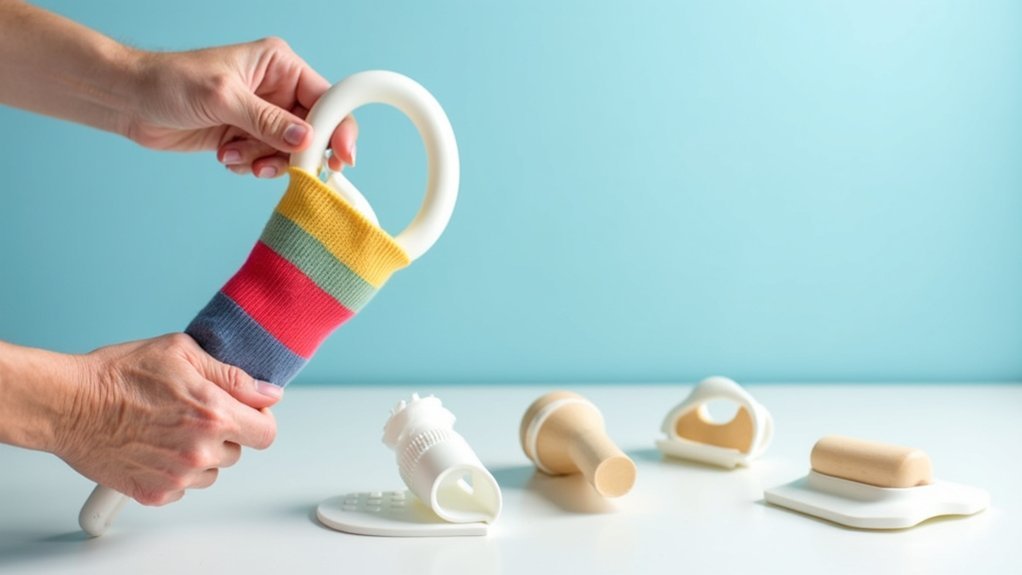
The three-finger sock aid design offers independence to those who struggle with daily dressing tasks, especially if you face mobility challenges from aging, disability, or recovery from surgery.
This clever device features a terrycloth exterior with a nylon interior, creating the perfect balance of grip without damaging your socks. The long straps eliminate bending and stooping, making it ideal if you’re recovering from knee replacement or back fusion surgery.
Occupational therapists regularly recommend this tool for maintaining independence. For best results, push your sock completely onto the device before sliding it onto your foot. It’s compatible with most sock types except compression socks.
Best For: Elderly individuals, disabled persons, those recovering from surgery, pregnant women, and anyone with limited mobility who struggles to bend down to put on socks.
Pros:
- Three-finger design with terrycloth exterior and nylon interior provides excellent grip without damaging socks
- Long straps eliminate the need for bending or stooping, restoring independence in daily dressing
- Compatible with most sock types and recommended by occupational therapists for post-surgery recovery
Cons:
- Not suitable for compression socks, limiting its usefulness for those with circulation issues
- Some users report asymmetrical construction, though functionality remains intact
- Requires proper technique (pushing sock fully onto device) for optimal effectiveness
RMS Deluxe Sock Aid – Socks Helper with Foam Handles (for Regular Socks)
Designed specifically for seniors with limited mobility and dexterity, this RMS Deluxe Sock Aid offers independence for those who struggle with bending or reaching their feet.
The flexible plastic shell (9.5″ × 5″ × 3″) features comfortable foam handles and a slip-resistant pad that keeps socks secure during application. With adjustable 38-inch ropes, you can customize the length to suit your needs.
It’s ideal for regular socks up to 5 inches wide—including ankle, athletic, and dress varieties—but not for compression stockings. Users recovering from surgery particularly appreciate how it prevents back strain while providing an affordable solution to maintaining self-sufficiency.
Best For: Seniors, post-surgery patients, and individuals with limited mobility who struggle to bend down to put on regular non-compression socks.
Pros:
- Flexible plastic shell with foam handles provides comfort and ease of use even for those with weak hand strength
- Adjustable 38-inch ropes can be customized to individual needs by tying new knots
- Slip-resistant foam pad keeps socks secure during application, preventing frustration
Cons:
- Not suitable for compression socks or stockings, limiting versatility for users with circulation issues
- May not work well for individuals with foot widths greater than 5 inches
- Some users might need practice to master the technique for optimal results
Fanwer Sock Aid Tool and Pants Assist for Elderly and Disabled
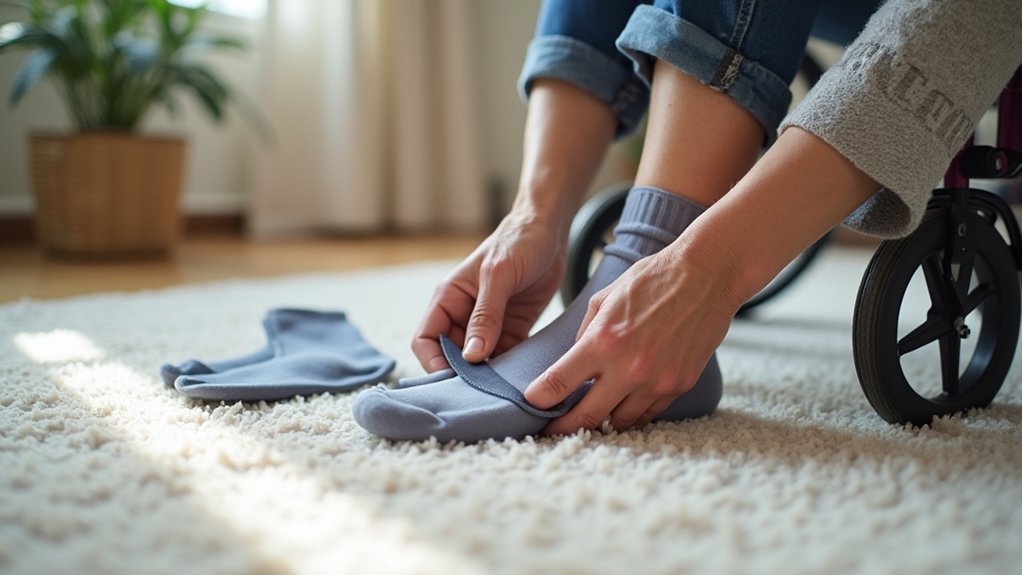
Seniors struggling with mobility challenges can regain their independence with the Fanwer Sock Aid Tool. This ergonomic device works in three simple steps: place your sock on the aid, slide it onto your foot, and pull gently.
You’ll appreciate the thoughtful design featuring a smooth inner layer for easy foot entry and terry cloth exterior that securely holds socks. The extended 33.5-inch handle eliminates bending, making it perfect if you have arthritis or are recovering from surgery.
It’s lightweight, portable, and accommodates various foot sizes. While excellent for regular socks, some users note it’s less effective with compression or dress socks.
Best For: Elderly, disabled individuals, pregnant women, and people recovering from surgery who struggle with bending or mobility issues when putting on socks.
Pros:
- Features an ergonomic design with a smooth inner layer and terry cloth exterior that effectively holds socks in place
- Includes a 33.5-inch extended handle that eliminates the need to bend, reducing strain for those with arthritis or spinal issues
- Lightweight, portable, and accommodates a wide range of foot sizes, making it versatile for different users
Cons:
- May not work effectively with compression socks, which require more force to pull on
- Some users report durability issues with the straps that may affect long-term use
- Not ideal for all sock types, particularly dress socks or sports socks with unique designs
Rehabilitation Advantage Sock Aid with Foam Handles, Standard
Independent dressing becomes effortless with the Rehabilitation Advantage Sock Aid with Foam Handles, Standard model. This lightweight ABS plastic device measures 9⅝” × 5″ × 3″ with 33″ cords and features comfortable foam handles.
You’ll appreciate its simple operation—just place your sock over the core, insert your foot, and pull the handles to slide the sock up your leg. The non-slip rubber pad keeps socks secure during application.
Many users recovering from surgery or managing arthritis find this tool life-changing. It works best with diabetic or loosely fitting socks and can be operated one-handed, making it ideal for seniors with limited mobility.
Best For: Individuals with limited mobility, recent surgery patients, elderly people, and those with conditions like arthritis or back pain who struggle to bend down to put on socks independently.
Pros:
- Lightweight ABS plastic design with comfortable foam handles allows for one-handed operation, making it accessible for users with various mobility limitations
- Non-slip rubber pad effectively keeps socks secure during application, preventing slipping and frustration during use
- Long 33″ cords provide ample reach for users who cannot bend, making it suitable for a wide range of mobility challenges
Cons:
- Works best with looser socks like diabetic socks; may be difficult to use with tight-fitting or thick athletic socks
- Some users report concerns about potential cracking of the plastic core with extended use
- May require practice and patience to master the technique, particularly for first-time users or those with significant dexterity issues
Skil-Care Easy-On Sock Aid for Seniors & Disabled
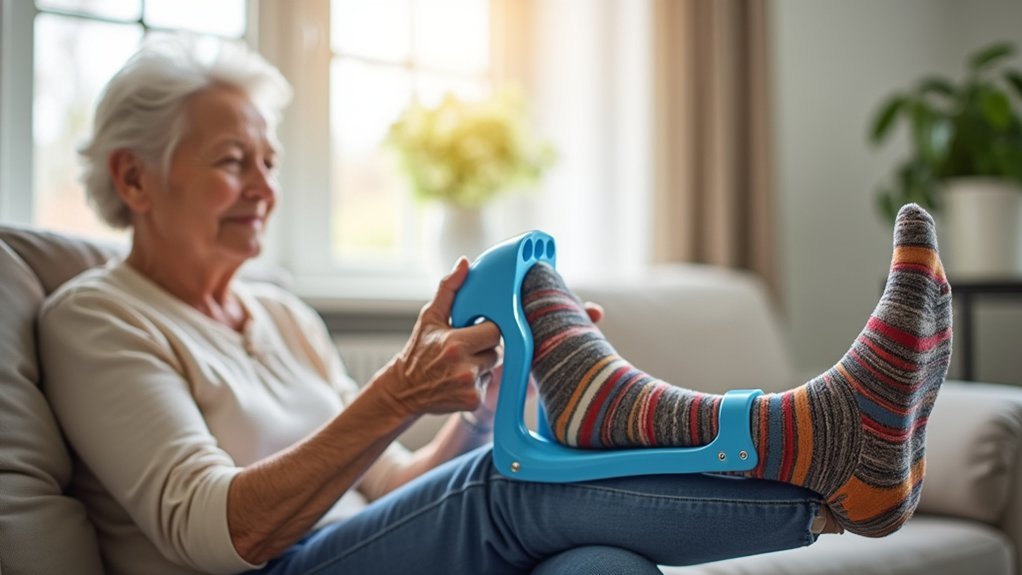
The Skil-Care Easy-On Sock Aid Model 810106 offers a practical solution for individuals with limited mobility who struggle with daily dressing tasks. Its ergonomic grip handles provide secure control while putting on socks without bending or straining.
You’ll appreciate the flexible design that accommodates various sock types, including diabetic and compression options. The lightweight, portable construction includes a carrying bag for convenience.
While many users praise its effectiveness and smooth fabric for easy foot sliding, some report challenges with the device collapsing during use. Others note difficulties in sock placement and alignment. Consider your specific needs when comparing this to harder plastic alternatives that might offer more stability.
Best For: Seniors, disabled individuals, and those recovering from surgery who need assistance putting on socks without bending or reaching.
Pros:
- Ergonomic grip handles provide secure control without slipping or straining
- Flexible design accommodates various sock types including diabetic and compression socks
- Lightweight and portable with included carrying bag for easy transport
Cons:
- Flexible structure may collapse during use, causing frustration for some users
- Some users report difficulties with proper sock placement and foot alignment
- Lacks sock removal functionality that some competing products offer
Factors to Consider When Choosing Sock Aid Devices for Seniors and Disabled
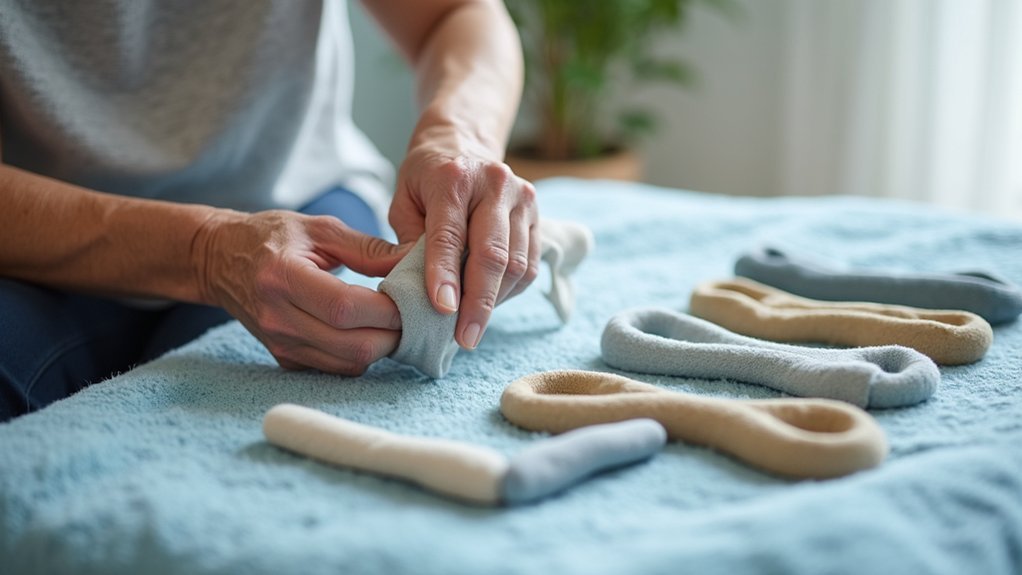
When selecting a sock aid device, you’ll need to evaluate your specific mobility limitations to find the right match for your needs. You should look for features like easy grip handles, appropriate length options, and compatibility with your preferred sock types. The material and design of the sock aid will affect both durability and how smoothly your socks slide on, making these important factors in your decision process.
Mobility Requirements Assessment
Properly evaluating mobility requirements stands as the cornerstone of selecting an appropriate sock aid device for seniors and disabled individuals. You’ll need to assess your ability to bend, twist, and reach, as these movements directly impact which design will work best for your situation.
If you’re recovering from surgery, look for devices that enable gentle application without straining healing areas. For those with limited hand strength, choose sock aids with ergonomic grips and user-friendly mechanisms to maintain independence.
Don’t overlook your foot size and preferred sock types when making your selection. Some devices are specifically designed for particular sock styles or foot widths. Additionally, evaluate whether you need a longer aid and if one-handed operation is essential for your daily dressing routine.
Ease of Use
Selecting a sock aid with ideal usability features guarantees that seniors and disabled individuals can maintain their independence while dressing. Look for ergonomic designs with grip handles that prevent slipping while pulling socks up.
You’ll want a device with a smooth inner surface that reduces friction and makes foot entry effortless. Consider models with adjustable ropes or straps that accommodate your height and personal preferences—these adaptations are vital if you have limited mobility.
Don’t overlook the importance of lightweight, portable designs that you can easily store or pack for travel. This portability assures you’ll maintain independence wherever you go.
Finally, choose products that include clear instructions for best usage. Proper guidance will help you maximize the effectiveness of your sock aid and guarantee a smoother, frustration-free dressing experience.
Design and Material
The design and material composition of sock aid devices greatly impact their functionality for seniors with limited mobility. When selecting a device, look for ergonomic features like soft grip handles and flexible structures that accommodate different sock types, including thicker compression socks.
Quality construction matters—durable plastic options provide longevity, while terrycloth versions offer superior grip for slippery socks. The best devices are lightweight and portable, making them practical for both home use and travel.
Pay attention to adjustability features, particularly strap length. Longer straps allow you to put on socks without excessive bending, essential if you have back problems or mobility issues. Many premium models now offer customizable components that can be tailored to your specific needs and limitations.
Sock Type Compatibility
Four essential sock varieties can determine which aid device will serve you best. Regular ankle, calf, and knee-length socks typically work with most devices, while compression and dress socks require specialized aids designed for thicker, less flexible materials.
You’ll find that loosely fitting socks slide more easily onto your feet with standard sock aids, reducing frustration during your daily dressing routine. When selecting a device, check whether it explicitly mentions compatibility with your preferred sock types.
Flexible-structured aids generally accommodate a wider range of sock styles compared to rigid models, adapting better to different fabric thicknesses. For maximum independence, prioritize devices matching your specific sock needs—whether you wear diabetic socks, wool varieties, or thin dress socks—rather than struggling with an incompatible aid that complicates rather than simplifies your dressing process.
Handle Length Options
Choosing appropriate handle length stands as one of the most critical factors when selecting a sock aid device. Typical handles range from 30 to 40 inches, with longer options providing better reach for those with severe mobility issues or back problems. This extended range minimizes the need to bend, reducing strain and discomfort during sock application.
You’ll want to take into account your specific physical limitations when selecting handle length. An adjustable handle offers versatility, accommodating different heights and preferences while enhancing overall comfort. The right length provides proper leverage, making the sock application process considerably easier.
Weight and Portability
Beyond handle length, weight and portability stand among the foremost considerations when selecting a sock aid device for seniors and those with disabilities. You’ll want to choose lighter models that won’t cause strain during use, especially for individuals with limited strength in their arms or hands.
The best sock aids combine lightweight design with durability, offering long-term value without becoming burdensome. Look for compact options that you can easily store in a bedside drawer or pack in a travel bag. These portable aids enable you to maintain your dressing independence whether you’re at home, visiting family, or attending rehabilitation sessions.
A truly portable sock aid empowers you to manage your daily dressing routine confidently and independently, regardless of location—a seemingly small feature that dramatically improves quality of life.
Durability and Construction
The three pillars of a long-lasting sock aid device rest on construction materials, design flexibility, and structural reinforcement. When selecting your sock aid, prioritize durable materials like ABS plastic or reinforced fabric that won’t buckle under daily use. These materials maintain their integrity even with consistent pressure.
Look for devices that strike the perfect balance between flexibility and sturdiness. You’ll want a sock aid that’s pliable enough to manipulate easily but won’t warp or bend permanently. Non-slip grips and rubber pads are essential features that prevent sock slippage while protecting the device from unnecessary strain.
Don’t overlook the pulling mechanisms—opt for longer, stronger cords that won’t fray or snap. Remember, proper care extends longevity; even the sturdiest aids require maintenance, especially those with softer components.
Frequently Asked Questions
Can Sock Aids Be Used With Compression Stockings?
You can use sock aids with compression stockings, but you’ll need specialized aids designed specifically for compression wear. Standard sock aids often can’t handle the tighter elasticity of compression stockings effectively.
How Do I Clean and Maintain My Sock Aid Device?
Clean your sock aid with mild soap and water, wiping it dry immediately to prevent damage. Don’t submerge plastic devices with foam parts. Regularly check for cracks or wear that might affect performance.
Are Sock Aids Suitable for People With Arthritis?
Yes, sock aids are ideal for people with arthritis. They’re designed to reduce hand strain and painful movements when putting on socks. You’ll find them especially helpful during arthritis flare-ups that limit your mobility.
Can Children Use Sock Aid Devices?
Yes, children can use sock aid devices. You’ll find they’re especially helpful for kids with mobility issues or those learning to dress independently. Simply choose a smaller, child-friendly model for easier handling.
Do Medicare or Insurance Plans Cover Sock Aid Devices?
Medicare may cover sock aid devices through Part B if prescribed by your doctor as medically necessary. Private insurance coverage varies by plan, so you’ll need to check with your specific provider for details.

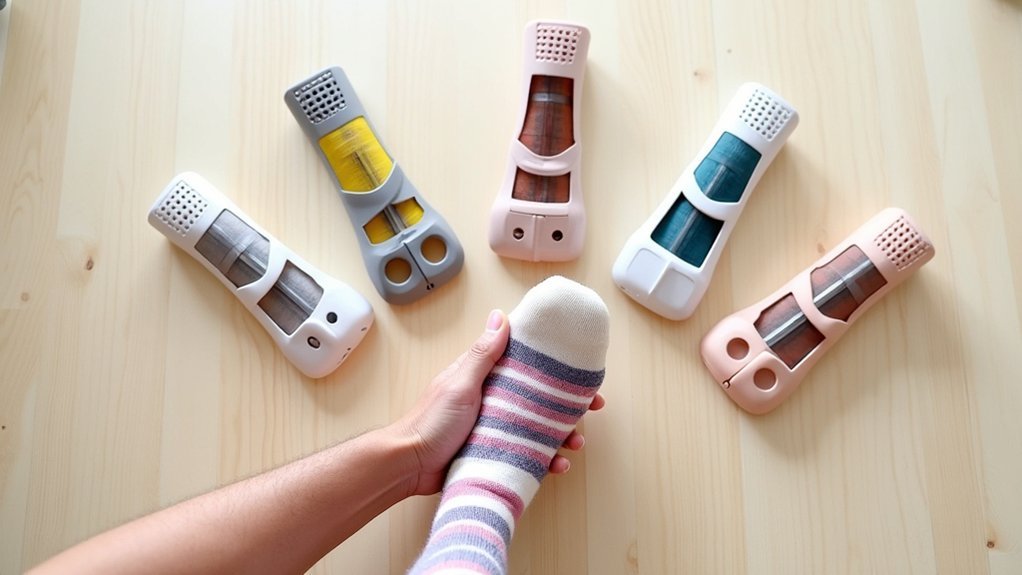



Leave a Reply